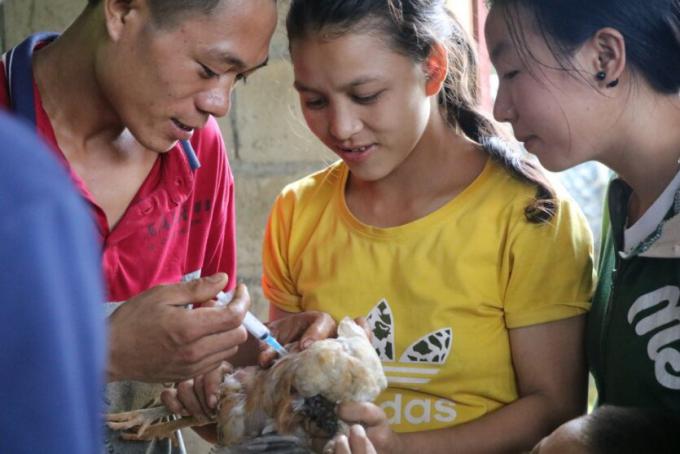Child Protection
Lao PDR has an estimated population of 7.4 million with around 49.6% of the population being children and young people below the age of 25 years; and 62% are age under 15. (LAOSIS, 2022)
Child protection issues affecting children and youths in Laos are largely associated with poverty as well as rapid-social economic changes. These changes have resulted in a spike in rural-urban migration, meaning that children are increasingly accompanying their migrant working parents or being left behind, cared for in temples, boarding schools or orphanages, or with extended family.
Save the Children International in Laos is dedicated to Child Protection, with a specific emphasis on reducing harmful practices, including early marriage; protecting children from violence, including physical and humiliating punishment and sexual violence; protecting them from trafficking, and from harmful work. The program aims to build life skills, improve gender equity, and establish community-based child protection initiatives.
In the 2021 Global Childhood Report published by Save the Children, Laos was placed 143rd out of 186 nations on an index that measured each nation's average performance on eight different dimensions pertaining to child health, education, labour, marriage, childbirth, and violence.
According to the research, 23.2 percent of children in primary and secondary school ages were not in school in 2015–2019, and 28.2 percent of youngsters aged five to seventeen worked during same time.

Early marriage and child-bearing are also common in most rural areas of Laos, 43% of all rural women are married before age 18, compared with just 23% in urban areas. 10% of married women gave birth before age 18, 38% before the age of 15 (Girls Not Brides, 2022).
The commercial sexual exploitation of children remains a persistent yet sensitive issue in Laos with child prostitution and human trafficking being common place; poverty, and a low level of law enforcement have also led to an increase in Child Sex Tourism.
- School girls participated in the Graduation Ceremony of community's young friendship circle at Nam Bak district, Luang Prabang Province.
Save the Children takes a holistic view of children considering all aspects of a child while making strategic choices and setting priorities. We work alongside children to increase their awareness and understanding of their rights, support them in having their voices heard, and encourage their involvement in programme and policy development. Save the Children also works with families, other primary care givers and communities to protect and promote children’s rights.
The organization employs a multi-stakeholder approach to preventing and responding to Child Early Forced Marriage. The overarching goal is to strengthen community-based child protection, shielding children from violence, harmful practices, and early forced marriages.
Our Programme
“Strengthening Child Protection Systems to Keep Children Safe” helps to ensure that children are protected from abuse, neglect, exploitation and violence through appropriate preventative and remedial interventions. Interventions at the village, district and provincial level are designed to contribute to the development of an effective and functioning provincial Child Protection. This project will enable the rights of Lao children under the national Law on the Protection of the Rights and Interests of Children (LPRC).
With government partners, children, and youths, the project seeks to initiate sustainable behaviour change amongst parents, teachers, community leaders, and children and young people themselves to protect rural and urban children from abuse, exploitation, neglect and violence.
Empowering Children and Adolescents
Save the Children actively involves children and adolescents in its initiatives. Through the Friendship Circle, young adolescents learn life skills, understand the impacts of early forced marriage, and gain the ability to negotiate with their parents. Peer-to-peer learning helps them comprehend the unacceptability of genderbased violence and learn about shared responsibilities and the potential for changing gender roles.

- Out-of-school girls are practicing vaccinating chicken during the technical training.
Life skills training is provided to out-of-school girls and young mothers, addressing the negative impacts of early marriage. The focus extends to safe income generation, seeking learning opportunities, and avoiding early and forced marriages. Professional technical partners contribute to training on income generating activities, financial literacy, and seed funding for small businesses. Learn more about Onsy, the beneficiary of Preventing Child Early and Forced Marriage Project.
Working with Families and Engaging with Community and Society
Save the Children conducts Safe Family training for all families intarget areas. This initiative emphasizes positive care for children, fostering understanding among parents and caregivers. The aim is to create protected and well-cared-for children for the benefit of families, communities, and society.
Collaboration extends to Village Authorities, promoting child protection and gender equality through training. The community-centric approach identifies root causes of gender inequality and child abuse, proposing actionable solutions. Save the Children facilitates the establishment of model non-violence parenting families and supports the dissemination of laws related to child protection and violence against women and children.
Save the Children actively engages with government partners, organizing community campaigns against violence and promoting child rights. National-level campaigns against Child Early Forced Marriage involve collaboration with other NGOs and UN agencies. Partnerships with civil society organizations focus on women's leadership, climate change, and STEM initiatives.
Where We Work and Our Impacts
Save the Children’s Child Protection Program is active in Luang Prabang provinces. In 2023, more than 5,000 children and 5,600 adults were reached directly through Frinedship circle activities, training and campaining to stop violence against women and children at the provincial and district levels.
 Laos
Laos